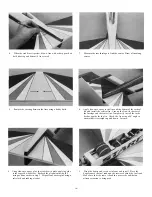
TRANSPORTING CHECKLIST
Before leaving for the flying field go though the checklist. This will
help prevent you from forgetting to take things with you.
1. Make sure that the transmitter and receiver batteries are fully
charged.
2 Glow plug clip and fully charged 1 1/2 volt battery (Hot-Shot glo-
starter)
Fuel and fuel pump or fuel bulb.
Extra props and prop wrench
Screw drivers, knife, pliers, and wrenches.
Epoxy and something to mix it on.
Paper Towels
Cleaner to remove residue on the plane (glass cleaner works
great)
9 Extra glow plugs
10 Electric starter or chicken stick.
IMPORTANT SAFETY MEASURES
RECEIVER BATTERY
1 Always make sure the receiver battery pack is fully charged
before flying
2. Wrap the receiver battery in 1/2" soft foam rubber to protect it
from engine vibration and shock A rubber band may be used to
hold the foam around the battery pack It is also suggested to
place the battery pack in a plastic bag to protect it from fuel
3. If using NiCd batteries, follow the instructions that came with
your radio for charging and care of the batteries
4. Before the first flight of the day, check all the wires on the battery
pack and switch for corrosion or broken wires
5. Do a pre-flight check of your radio system each flying session.
RECEIVER
1. Never cut the receiver antenna This will affect the sensitivity of
the receiver and result in a loss of range
2. Carefully wrap the receiver in foam and a plastic bag like the
receiver battery
3. Make sure that all the servos are plugged tightly into the correct
receiver terminal
RADIO CHECK
Always check the operation of your radio before you fly to see that the
control surfaces move in the proper directions and that they move the
proper amount If the direction of rotation needs to be reversed to
correct for reversed controls, simply change the side of the servo arm
to which the push rod is attached or flip the proper servo reversing
switch on your transmitter To INCREASE the amount of movement
that the surface will have, move the SNAP CLEVIS CLOSER to the
surface or move the ROD CLEVIS away from the center of the servo
arm To DECREASE the amount of movement, move the SNAP
CLEVIS AWAY from the surface or move the ROD CLEVIS closer to
the center of the servo arm.
SERVOS
1. Make sure that all the control surfaces move smoothly without
binding When installing the push rods the servo must be able to
move through its complete range of rotation
2 If the servo buzzes when the transmitter stick is moved to its
limit, the servo still has some movement left But the flying
surface being moved is at its limit This can damage the servo
and drain the battery which may cause loss of control of the plane
and crash If this happens, move the control rod in closer to the
center of the servo to reduce the chance of binding Make sure to
double check the servo throws afterwards. Recenter as necessary
23.


































